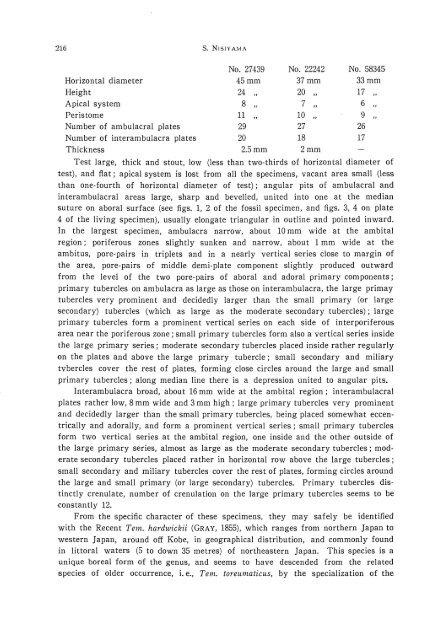the echinoid fauna from japan and adjacent regions part i
the echinoid fauna from japan and adjacent regions part i
the echinoid fauna from japan and adjacent regions part i
You also want an ePaper? Increase the reach of your titles
YUMPU automatically turns print PDFs into web optimized ePapers that Google loves.
216<br />
Horizontal diameter<br />
Height<br />
Apical system<br />
Peristome<br />
Number of ambulacral plates<br />
Number of interambulacra plates<br />
Thickness<br />
S. NISIYAMA<br />
No. 27439<br />
45mm<br />
24<br />
"<br />
8<br />
"<br />
11<br />
29<br />
20<br />
2.5mm<br />
No. 22242 No. 58345<br />
37mm 33mm<br />
20<br />
7<br />
"<br />
17<br />
6<br />
"<br />
10<br />
27<br />
"<br />
9<br />
26<br />
18 17<br />
2mm<br />
Test large, thick <strong>and</strong> stout, low (less than two-thirds of horizontal diameter of<br />
test), <strong>and</strong> fiat; apical system is lost <strong>from</strong> all <strong>the</strong> specimens, vacant area small (less<br />
than one-fourth of horizontal diameter of test); angular pits of ambulacral <strong>and</strong><br />
interambulacral areas large, sharp <strong>and</strong> bevelled, united into one at <strong>the</strong> median<br />
suture on aboral surface (see figs.!, 2 of <strong>the</strong> fossil specimen, <strong>and</strong> figs. 3, 4 on plate<br />
4 of <strong>the</strong> living specimen), usually elongate triangular in outline <strong>and</strong> pointed inward.<br />
In <strong>the</strong> largest specimen, ambulacra narrow, about 10 mm wide at <strong>the</strong> ambital<br />
region; poriferous zones slightly sunken <strong>and</strong> narrow, about 1 mm wide at <strong>the</strong><br />
ambitus, pore-pairs in triplets <strong>and</strong> in a nearly vertical series close to margin of<br />
<strong>the</strong> area, pore-pairs of middle demi-plate component slightly produced outward<br />
<strong>from</strong> <strong>the</strong> level of <strong>the</strong> two pore-pairs of aboral <strong>and</strong> adoral primary components;<br />
primary tubercles on ambulacra as large as those on interambulacra, <strong>the</strong> large primay<br />
tubercles very prominent <strong>and</strong> decidedly larger than <strong>the</strong> small primary (or large<br />
secondary) tubercles (which as large as <strong>the</strong> moderate secondary tubercles); large<br />
primary tubercles form a prominent vertical series on each side of interporiferous<br />
area near <strong>the</strong> poriferous zone; small primary tubercles form also a vertical series inside<br />
<strong>the</strong> large primary series; moderate secondary tubercles placed inside ra<strong>the</strong>r regularly<br />
on <strong>the</strong> plates <strong>and</strong> above <strong>the</strong> large primary tubercle; small secondary <strong>and</strong> miliary<br />
tvbercles cover <strong>the</strong> rest of plates, forming close circles around <strong>the</strong> large <strong>and</strong> small<br />
primary tubercles; along median line <strong>the</strong>re is a depression united to angular pits.<br />
Interambulacra broad, about 16 mm wide at <strong>the</strong> ambital region; interambulacral<br />
plates ra<strong>the</strong>r low, 8 mm wide <strong>and</strong> 3 mm high; large primary tubercles very prominent<br />
<strong>and</strong> decidedly larger than <strong>the</strong> small primary tubercles, being placed somewhat eccentrically<br />
<strong>and</strong> adorally, <strong>and</strong> form a prominent vertical series; small primary tubercles<br />
form two vertical series at <strong>the</strong> ambital region, one inside <strong>and</strong> <strong>the</strong> o<strong>the</strong>r outside of<br />
<strong>the</strong> large primary series, almost as large as <strong>the</strong> moderate secondary tubercles; moderate<br />
secondary tubercles placed ra<strong>the</strong>r in horizontal row above <strong>the</strong> large tubercles;<br />
small secondary <strong>and</strong> miliary tubercles cover <strong>the</strong> rest of plates, forming circles around<br />
<strong>the</strong> large <strong>and</strong> small primary (or large secondary) tubercles. Primary tubercles distinctly<br />
crenulate, number of crenulation on <strong>the</strong> large primary tubercles seems to be<br />
constantly 12.<br />
From <strong>the</strong> specific character of <strong>the</strong>se specimens, <strong>the</strong>y may safely be identified<br />
with <strong>the</strong> Recent Tem. hardwickii (GRAY, 1855), which ranges <strong>from</strong> nor<strong>the</strong>rn <strong>japan</strong> to<br />
western <strong>japan</strong>, around off Kobe, in geographical distribution, <strong>and</strong> commonly found<br />
in littoral waters (5 to down 35 metres) of nor<strong>the</strong>astern <strong>japan</strong>. This species is a<br />
unique boreal form of <strong>the</strong> genus, <strong>and</strong> seems to have descended <strong>from</strong> <strong>the</strong> related<br />
species of older occurrence, i. e., Tem. toreumaticus, by <strong>the</strong> specialization of <strong>the</strong>












